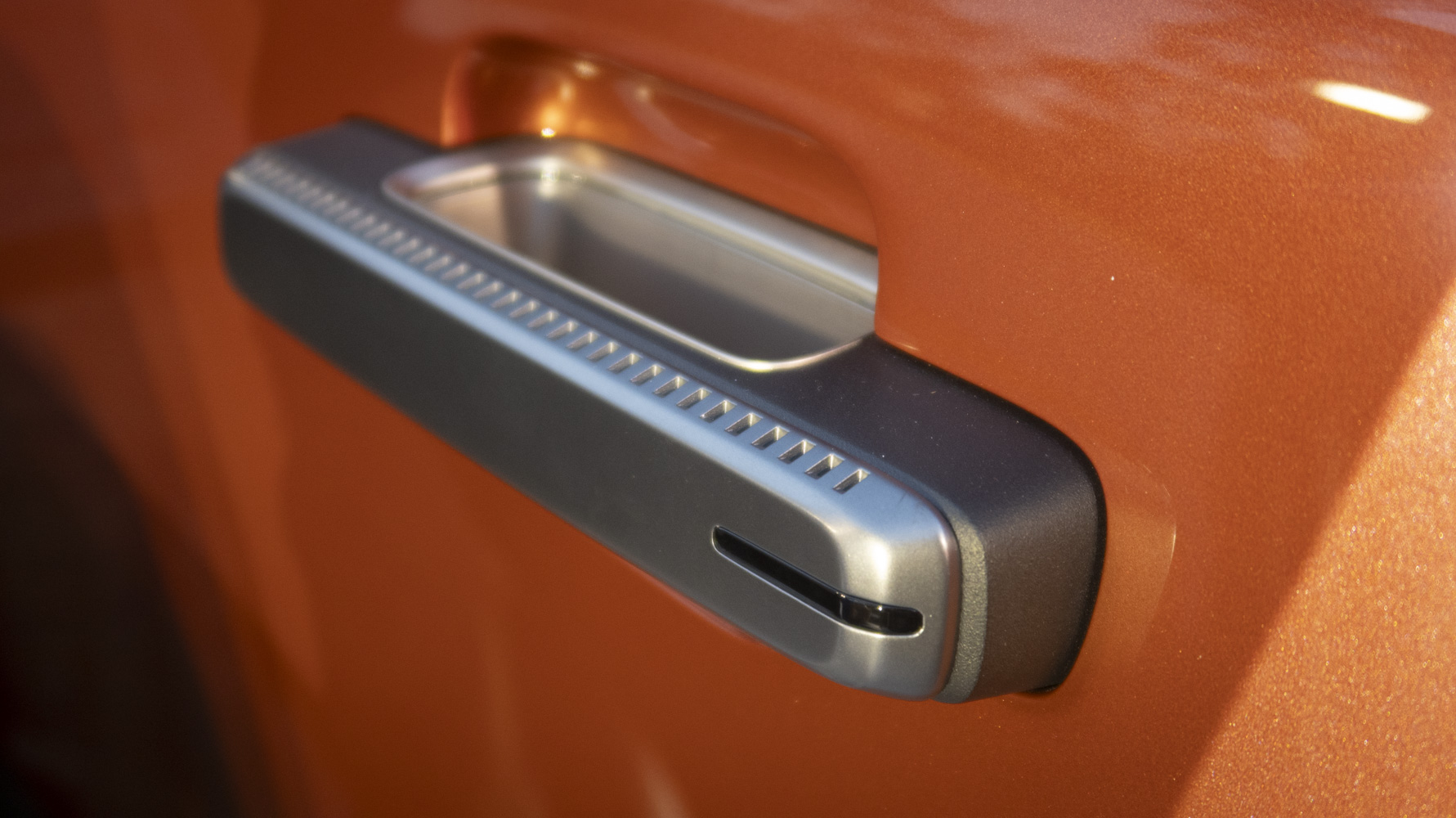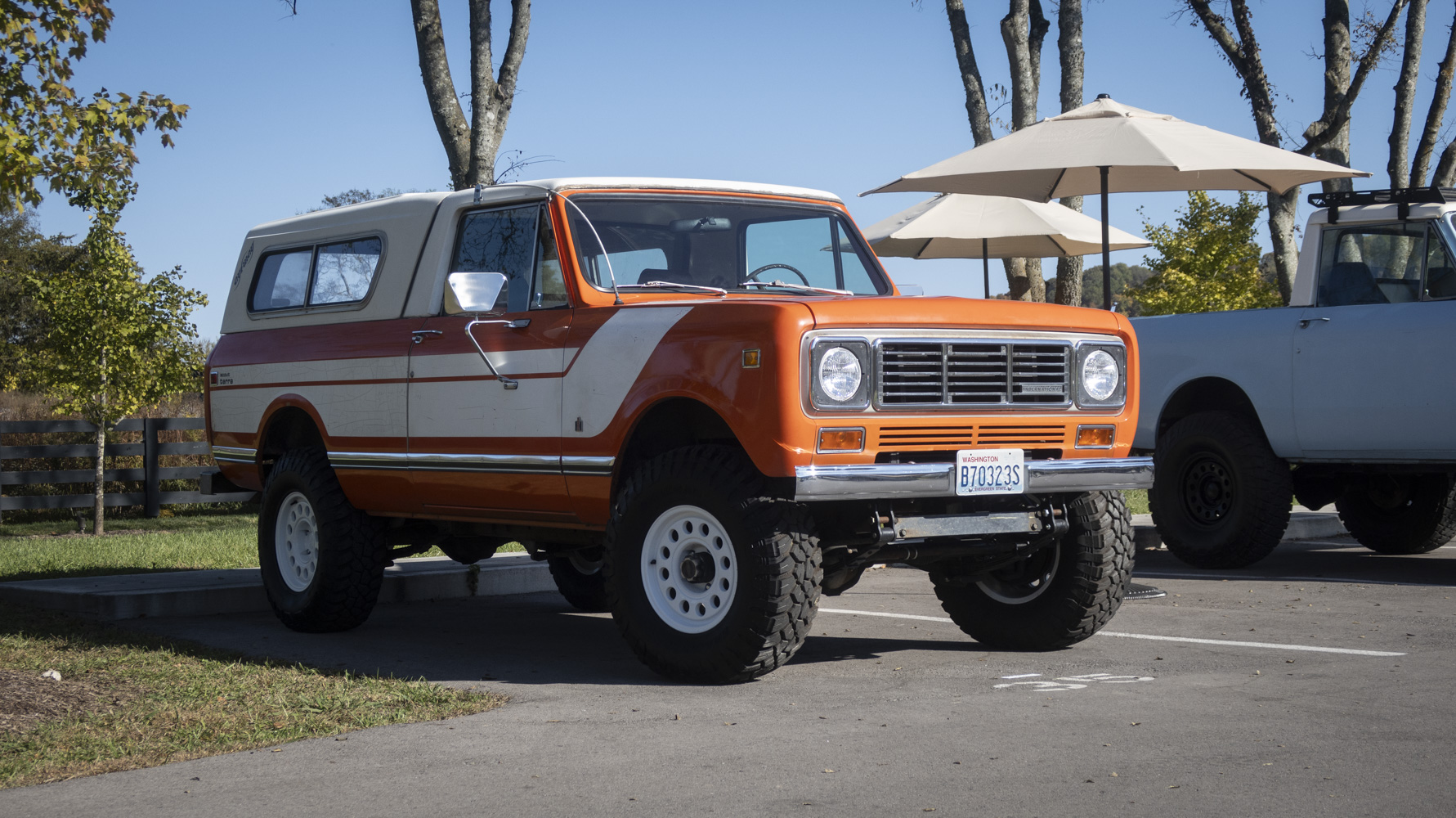The new Scout Motors brand has been busy building its business infrastructure and a colossal American manufacturing facility. But yesterday, the return of Scout started to feel a lot more real as two fleshed-out concept designs were presented at a blowout launch party in Tennessee. I watched the reveal standing shoulder to shoulder with other off-road enthusiast writers, dudes in the classic Scout restoration business, and even one gentleman who worked on Scout designs in the 1970s. They were pretty unanimously impressed. I liked what I saw too, but it still wasn’t quite enough to get me jump-for-joy excited about the near-term future of cars and trucks.
The Look
It’s big, it’s clean, and the details help it nail a form/function balance.
The comment I’ve seen the most under stories and IG posts about the Scout concepts is that they look like re-skinned Rivians. There are, without a doubt, broad-stroke similarities. That rear window kink in the pickup truck, in particular, undeniably invites comparisons to the R1T. But it’s also a legitimate nod to a ’70s Scout design element.

I feel strongly that the Scout designs are sufficiently distinctive from other vehicles on the market. Even without the range extender, Scout’s biggest unique value proposition in the EV truck space at this point, the Scout Traveler looks different enough from a Ford Bronco or Rivian R1S to make the choice non-trivial. The sameness you’re seeing is a byproduct of the segment’s standards—there’s only so much you can do with the classic two-rectangle silhouette to make it look cool without turning it into a caricature.
For pickup trucks, the problem is even harder to avoid. Once you commit to traditional visual anchor points, there’s simply no way to create something iconoclastic. I mean, look at side-profile shots of a Toyota Tacoma and Nissan Frontier. When you’re trying to hit a quintessential nod-to-classic look, of course, it’s going to end up reminding you of the segment forerunners that inspired it.

Seeing the Scouts in person gave me the opportunity to appreciate the design flourishes that do make the machines unique, and there are some great ones. The proud fender flares and wide track stood out to me as impressive and classy. The split tailgate is awesome and the swing-out spare tire carrier is extremely cool. It’ll be a little annoying to use in practice, but it looks good (and Scout’s people pretty strongly indicated to me that it’ll be optional).
These things are also a lot bigger than I think casual commenters have been able to appreciate. The Terra’s truck bed is a whole foot longer than the Rivian R1T’s. The cargo area of the Traveler is cavernous.
The square headlights grew on me over the course of the last 12 hours, but I’m still not sure how I feel about the grille. Something about it makes me kind of sad. I appreciate its simplicity and I love an off-center emblem, but the Scout’s face feels a little lifeless to me. Perhaps the concept car’s matte plastic was largely to blame, though—the production model will assuredly use nicer materials.
I absolutely loved the button controls, general interior layout, and generous rear cargo area of the SUV model. The Scout switches have a Millennium Falcon vibe to me—simultaneously analog and futuristic. In a word: Perfect. The center infotainment screen is large, but it’s integrated with the dash much more deliberately than the huge sports bar TV you get in a Tacoma or the glued-on iPad look you get in everything else.
The Scout’s exterior door handles are great, too. I was very pleased to see they skipped the hideaway handles a few other makes use.
Traveler Details













Terra Details














The only thing that probably would have gotten my deposit last night, and I know, no way was this gonna happen, but … if they’d done true three-dimensional analog gauges for the main speedo/charge level/driver info cluster. Now that would have blown me away.
The Features
The optional gasoline-powered range extender is a game-changing concept for an EV off-roader. Not everybody’s a fan of EREV cars, but as far as I’m concerned, it’s the best thing Scout could have done to give this thing real adventure cred. Having a gasoline engine onboard does create complexity, add weight, and force you to do engine maintenance (a true bummer, because getting away from fluid changes is a major EV advantage). But it’s also an excellent hedge against “what if there’s nowhere to charge?” Which, if you’re really roaming far from home, is a concern no matter how good the electric car infrastructure gets.
I already talked about how much I liked the buttons and switched, but I also dig the frunk (it has cup holders and a place to sit!) and the optional slide-back cloth roof on the Traveler that Scout’s calling a “Cabana Roof.” Susceptible to leaks? Maybe. Makes it tougher to maintain a nice temperature in the cab? For sure. But to me, an open-air option is huge. I also noticed that the Terra has an enormous rear window on its Terra truck which looked like it might roll down. That’d be great too, classic Toyota Tundra Double Cab style.
What the Skeptics Said
There was a short shuttle bus ride from the parking lot to the stage where the new Scouts were revealed. I squeezed into the back of an E-450 with a phalanx of quintessential old-school truck boys. Black shirts, beards, beat-up boots, and I’m sure I spotted a “CUMMINS” tattoo. They were in good spirits on account of Scout Motors’ all-inclusive hospitality (the brand invited a bunch of Scout owners and restorers), but I didn’t have to talk to them long to learn that they were not into EVs at all.
About an hour later, after the CEO’s speech was over and the trucks were sitting for our inspection, I caught up with a couple of them again—they’d all plunked down $100 deposits already.
At another point I found myself standing next to Brian Scotto, of Hoonigan fame. I asked what he thought. “I wish I could see it without so many people around it,” he said noncommittally, but he seemed onboard with electric trucks. He told me he has a couple of off-roaders that “sound like an industrial zone” and appreciates the idea of quiet wheeling. I can get with that, for sure.
Emme Hall, a car writer who’s done heaps of off-road racing, driving, and wrenching in her career, was almost impressed enough to put down a reservation. And David Tracy, one of my best buds whose love of archaic trucks is extremely well-documented, was so stoked he actually did cough up the $100 for a Scout reservation while we were sitting together in a follow-up presentation.
Chad Kirchner, who’s been covering trucks for years, said something along the lines of “I wish I had more to complain about,” before half-jokingly asking me if I put a deposit down. When I said no, he followed with, “Is there anything they could have shown that would have gotten your deposit?” No, probably not. Despite covering new cars for the last decade, I’m debt averse to a fault and have never had a car note in my life.
But one of my favorite interactions at the Scout launch was with a gentleman named Dick Hatch. Mr. Hatch is a retired industrial designer who worked for International Harvester in the ’60s, ’70s, and ’80s. We actually talked for a really long time—I didn’t ask his age, but, you can kind of do the math based on his working years. He’s incredibly sharp and jovial and shared some great anecdotes about IH in the Scout’s era. Apparently he once did a concept mockup for a soybean processing machine that was supposed to cure world hunger (too bad that one didn’t pan out) and before that, he did some detail work on a few versions of the Scout.






Hatch wasn’t solely responsible for the original Scout or Scout II’s look; he told me the design team was about 25 people and when he joined the Scout program it was already well underway. He explained that he did some of the old truck’s trim and graphics. I told him how much I loved those, and that the Scout’s big flat side panels really lent themselves nicely to big splashy designs. He agreed and gave me a piece of insight I’ll have to paraphrase because I foolishly didn’t have a memo recorder running. He essentially articulated that the best vehicle designs do a lot with a little; less is more, basically. He said something like “so many vehicles have 11 or 10 design elements going on when they should have stopped at three.”
That was early in the day before the reveal when we had that conversation, and I was lucky enough to catch up with him again after the concept trucks came out. “I love it,” he told me emphatically. “It’s just right. Some cars have 100 too many things going on, this doesn’t have anything it doesn’t need.” Scout Motors had paid his way to be there, but they definitely weren’t paying him a salary—I’m 100% sure he would have shrugged and shuffled back to the buffet if he wasn’t earnestly impressed.
As far as OG endorsements go, a hearty heck-yeah from perhaps the only surviving IH Scout designer is pretty damn good.
But Production Is Still Years Away
Scout’s people say the South Carolina factory that’ll build the trucks will be done by the end of next year, but production of the actual vehicles isn’t projected to start until 2027. That’s a very long time in the world of technology and the value of money. A lot has to go right for Scout Motors to deliver vehicles on time and priced as promised, and regardless, the look and loadout of the things could still evolve quite a bit before they are on the road.
The concepts we saw this week were supposed to be “85% reality and 15% fantasy.” I like the way they look and, if EVs are more enticing in a couple of years, I could see myself coughing up the coin to have one of these.
I was telling one of the Scout Motors business guys that I have an old Scout, and like to go on adventure trips with my wife and dog. “You’re our target customer,” he said enthusiastically. On paper, he’s right—I’ve loved old Scouts for as long as I can remember but don’t drive very far in mine because it’s a slow and sloppy pain in the ass. Part of me feels weird for not doing cartwheels over the idea of a brand-new Scout Traveler. But as I thought about it, I realized, I don’t like my Scout for its rugged off-road capability or some Sam Elliott voiceover Americana nostalgia. I like it because it’s wacky, it’s loud, few people can easily identify it and even fewer can drive it.
I’ve heard and read a few times that electric cars are replacing gasoline-burning cars the way automobiles replaced horses over a century ago. Well, if I lived back then and I was really into horses, I might get a car to get around in, but I highly doubt it’d ever stoke the same emotions that come from a companion animal.

Read the full article here

